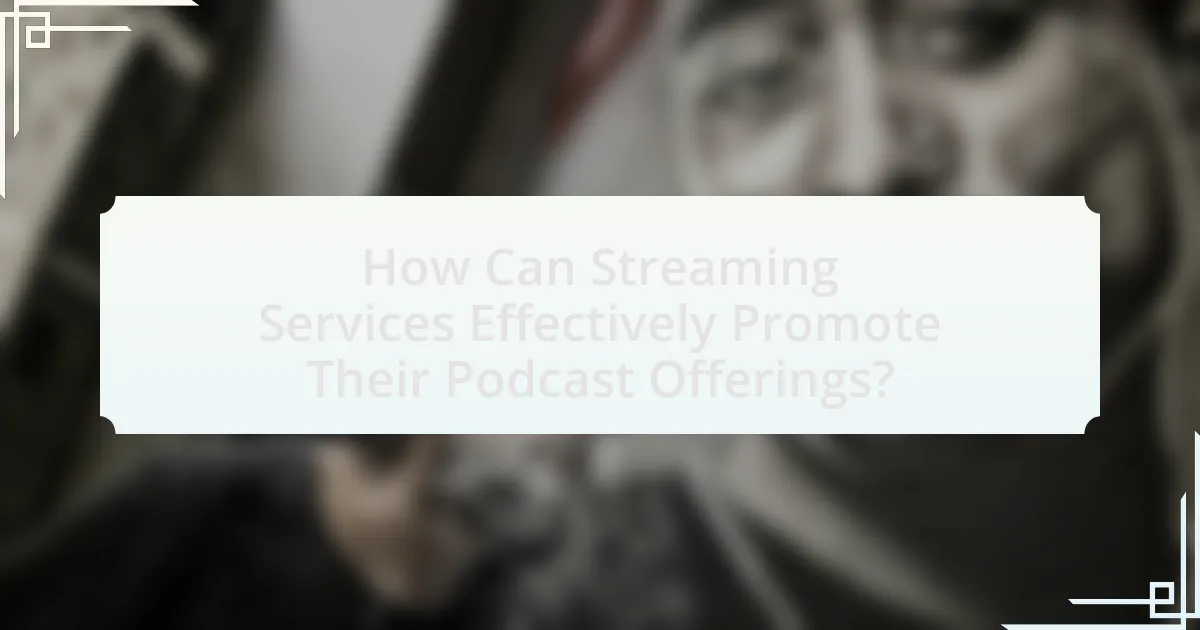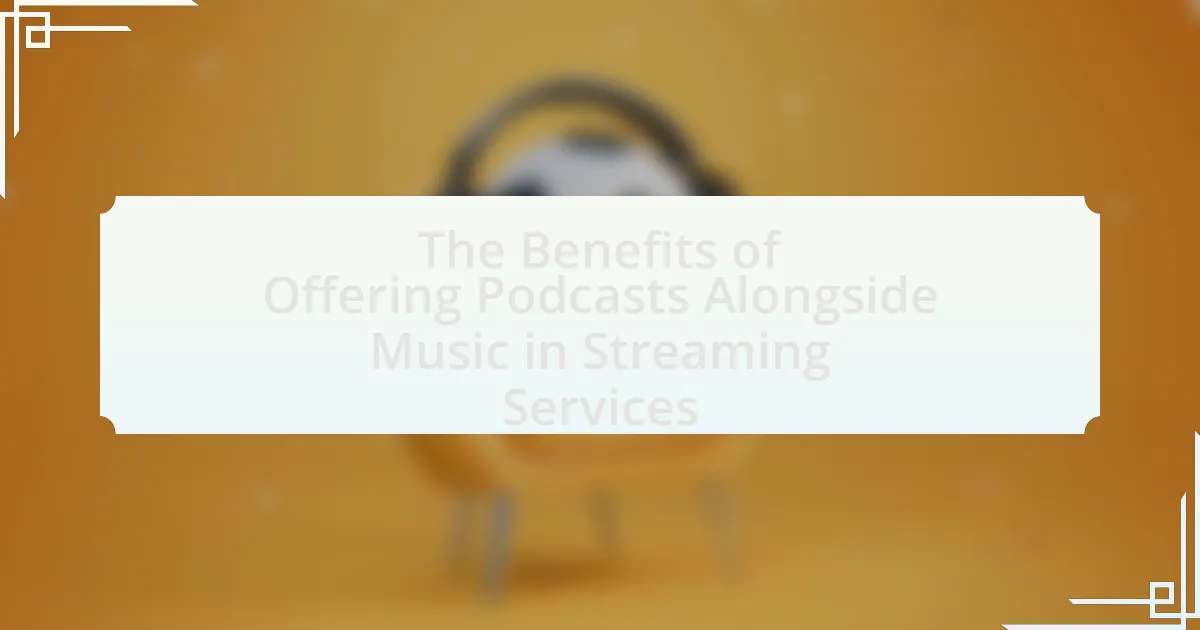The article examines the benefits of integrating podcasts alongside music in streaming services, highlighting how this dual offering enhances user engagement and retention. It discusses the diverse content that podcasts provide, which complements music by offering in-depth discussions and storytelling. The article also explores market trends driving this integration, potential revenue benefits, and strategies for maintaining content quality. Additionally, it addresses the challenges streaming services may face, such as content licensing and audience engagement, while emphasizing the importance of effective promotion and user feedback in optimizing podcast offerings.

What are the Benefits of Offering Podcasts Alongside Music in Streaming Services?
Offering podcasts alongside music in streaming services enhances user engagement and retention. By providing diverse content, streaming platforms can cater to a broader audience, appealing to both music lovers and podcast enthusiasts. This dual offering can increase the average time users spend on the platform, as they have more options to explore. For instance, a study by Edison Research found that 55% of podcast listeners also stream music, indicating a significant overlap in audience interests. Additionally, integrating podcasts can lead to higher subscription rates, as users perceive greater value in a service that offers varied audio content.
How do podcasts enhance the user experience on streaming platforms?
Podcasts enhance the user experience on streaming platforms by providing diverse content that caters to various interests and preferences. This variety allows users to engage with different formats, such as storytelling, interviews, and educational content, which can complement their music listening experience. Research indicates that 55% of podcast listeners report that they enjoy the format because it allows them to multitask, making it easier to consume content while performing other activities. Additionally, the integration of podcasts can increase user retention on platforms, as users are more likely to spend extended periods on services that offer a wide range of audio content.
What unique content do podcasts provide that music does not?
Podcasts provide in-depth discussions and storytelling that music does not offer. While music primarily delivers emotional experiences through melodies and lyrics, podcasts engage listeners with informative content, interviews, and narratives that explore various topics in detail. For instance, a podcast episode can feature expert interviews on current events, personal stories, or educational content, allowing for a deeper understanding of subjects. This format fosters a connection with the audience through dialogue and analysis, which is absent in music.
How can podcasts create a more engaging environment for listeners?
Podcasts create a more engaging environment for listeners by providing immersive storytelling and diverse content that captures attention. This format allows for deeper emotional connections, as hosts often share personal anecdotes and insights, fostering a sense of intimacy. Research indicates that 75% of podcast listeners feel a personal connection to the host, enhancing engagement levels. Additionally, the on-demand nature of podcasts enables listeners to choose topics that resonate with their interests, further increasing their involvement and satisfaction.
Why are streaming services incorporating podcasts into their offerings?
Streaming services are incorporating podcasts into their offerings to enhance user engagement and diversify content. By adding podcasts, these platforms can attract a broader audience, as research indicates that 55% of the U.S. population has listened to a podcast, showcasing significant demand. Additionally, podcasts can increase user retention; for instance, Spotify reported that users who engage with podcasts spend more time on the platform compared to those who only listen to music. This strategy not only boosts subscription rates but also creates new advertising opportunities, as brands are increasingly interested in podcast sponsorships, which can yield higher ROI compared to traditional advertising methods.
What market trends are driving the inclusion of podcasts in music streaming?
The market trends driving the inclusion of podcasts in music streaming are the growing demand for diverse audio content and the increasing popularity of on-demand listening. Consumers are seeking more than just music; they want engaging narratives and informative discussions, which podcasts provide. According to a 2021 report by Edison Research, 41% of Americans aged 12 and older have listened to a podcast in the past month, indicating a significant rise in podcast consumption. Additionally, music streaming platforms are recognizing that integrating podcasts can enhance user engagement and retention, as evidenced by Spotify’s investment in exclusive podcast content, which has led to increased user subscriptions and time spent on the platform.
How do podcasts help streaming services differentiate themselves from competitors?
Podcasts help streaming services differentiate themselves from competitors by providing unique content that enhances user engagement and retention. Unlike traditional music offerings, podcasts offer diverse topics and formats, attracting a wider audience and encouraging longer listening sessions. For instance, Spotify has invested heavily in exclusive podcast content, such as “The Joe Rogan Experience,” which has significantly increased its user base and engagement metrics. This strategic move not only sets Spotify apart from competitors like Apple Music but also positions it as a comprehensive audio platform, catering to both music and spoken-word content preferences.
What are the potential revenue benefits of adding podcasts to music streaming services?
Adding podcasts to music streaming services can significantly increase revenue through diversified content offerings, enhanced user engagement, and advertising opportunities. By incorporating podcasts, streaming platforms can attract a broader audience, as studies show that 55% of the U.S. population has listened to a podcast, indicating a growing market. Additionally, podcasts can lead to longer user sessions, which in turn can boost subscription retention rates and reduce churn.
Moreover, the podcast advertising market is projected to reach $2 billion by 2023, providing streaming services with a lucrative revenue stream through targeted ads. Platforms like Spotify have already reported increased ad revenue after integrating podcasts, demonstrating the financial viability of this strategy. Thus, the addition of podcasts not only enhances user experience but also creates multiple avenues for revenue generation.
How can advertising revenue be maximized through podcast integration?
Advertising revenue can be maximized through podcast integration by leveraging targeted advertising and audience engagement strategies. By utilizing data analytics, streaming services can identify listener demographics and preferences, allowing for personalized ad placements that resonate with specific audiences. Research indicates that targeted ads can increase engagement rates by up to 50%, leading to higher conversion rates and increased revenue. Additionally, integrating dynamic ad insertion technology enables real-time updates to advertisements, ensuring that content remains relevant and timely, further enhancing listener retention and advertiser satisfaction.
What subscription models can be enhanced by offering podcasts?
Subscription models that can be enhanced by offering podcasts include tiered subscription services, freemium models, and bundled content packages. Tiered subscription services benefit from podcasts by providing exclusive audio content to higher-paying subscribers, increasing perceived value and customer retention. Freemium models can attract users with free podcast content, encouraging upgrades to premium subscriptions for ad-free experiences or additional features. Bundled content packages that combine music and podcasts can enhance user engagement and satisfaction, as evidenced by platforms like Spotify, which reported increased user activity and subscription growth after integrating podcasts into their offerings.

What Challenges Might Streaming Services Face When Offering Podcasts?
Streaming services may face several challenges when offering podcasts, including content licensing issues, competition for exclusive content, and audience engagement. Content licensing can be complex, as streaming platforms must negotiate rights with multiple creators and networks, which can lead to legal disputes or increased costs. Additionally, competition is fierce, with numerous platforms vying for exclusive podcast deals, making it difficult for any single service to stand out. Audience engagement poses another challenge, as streaming services must effectively promote podcasts to attract listeners who may primarily use the platform for music, requiring strategic marketing efforts and user interface adjustments to enhance discoverability.
How can content quality be maintained across both music and podcasts?
Content quality can be maintained across both music and podcasts by implementing rigorous editorial standards and consistent production processes. Establishing clear guidelines for content creation ensures that both music tracks and podcast episodes meet high-quality benchmarks, such as sound clarity, engaging narratives, and relevant themes. For instance, platforms like Spotify and Apple Music utilize professional audio engineers and content curators to oversee the production and selection of both music and podcasts, ensuring that all offerings are polished and appealing to listeners. This dual approach not only enhances user experience but also fosters brand loyalty, as evidenced by Spotify’s significant growth in podcast listenership, which increased by 200% in 2020, demonstrating the effectiveness of maintaining high content standards across different audio formats.
What strategies can be implemented to ensure high-quality podcast production?
To ensure high-quality podcast production, implementing a combination of professional audio equipment, skilled editing, and clear content planning is essential. High-quality microphones and audio interfaces significantly enhance sound clarity, while experienced audio engineers can refine the final product through meticulous editing. Additionally, a well-structured script and defined episode format contribute to engaging content, ensuring that listeners remain interested. Research indicates that podcasts with high production values attract larger audiences, as evidenced by a 2021 report from Edison Research, which found that 80% of listeners prefer professionally produced podcasts over amateur ones.
How can streaming services manage the diverse audience expectations for music and podcasts?
Streaming services can manage diverse audience expectations for music and podcasts by implementing personalized recommendation algorithms and curating content that caters to various listener preferences. These algorithms analyze user behavior, such as listening history and engagement metrics, to suggest relevant music and podcasts, thereby enhancing user satisfaction. For instance, Spotify’s Discover Weekly playlist utilizes machine learning to tailor recommendations, resulting in increased user engagement and retention. Additionally, offering a wide range of genres and podcast formats, including interviews, storytelling, and educational content, allows streaming platforms to appeal to different demographics and interests, further meeting the varied expectations of their audience.
What technical challenges arise from integrating podcasts into music platforms?
Integrating podcasts into music platforms presents several technical challenges, primarily related to content management, user interface design, and audio streaming technology. Content management systems must be adapted to handle different metadata formats and categorization for podcasts, which often differ from music tracks. User interface design must accommodate the unique listening experience of podcasts, including features like episode navigation and show notes, which are not typically required for music. Additionally, audio streaming technology must ensure seamless playback of both music and podcasts, which may involve different encoding and buffering requirements. These challenges necessitate significant adjustments in the underlying architecture of music platforms to provide a cohesive user experience.
How can streaming services optimize their platforms for podcast delivery?
Streaming services can optimize their platforms for podcast delivery by implementing advanced algorithms for personalized recommendations, enhancing user interface design for easy navigation, and ensuring high-quality audio streaming. Personalized algorithms can analyze user listening habits to suggest relevant podcasts, thereby increasing engagement; for instance, Spotify’s recommendation system has been shown to significantly boost user retention. A user-friendly interface allows listeners to seamlessly browse and discover new content, which is crucial given that 75% of podcast listeners prefer platforms that facilitate easy content discovery. Additionally, maintaining high audio quality is essential, as studies indicate that 80% of users prioritize sound quality when choosing a podcast platform.
What are the implications of bandwidth and storage on podcast offerings?
Bandwidth and storage significantly impact podcast offerings by determining the quality and quantity of content that can be delivered to users. High bandwidth allows for streaming of high-quality audio, which enhances listener experience, while limited bandwidth can lead to buffering and lower audio quality, potentially deterring users. Storage capacity influences the number of episodes and the length of content that can be hosted; platforms with ample storage can offer extensive libraries, attracting more listeners. For instance, platforms like Spotify and Apple Podcasts utilize large storage solutions to host thousands of episodes, ensuring diverse content availability, which is crucial for user retention and engagement.

How Can Streaming Services Effectively Promote Their Podcast Offerings?
Streaming services can effectively promote their podcast offerings by leveraging targeted marketing strategies, such as personalized recommendations and cross-promotion within their existing platforms. Personalized recommendations utilize algorithms to suggest podcasts based on user listening habits, which can increase engagement; for instance, Spotify reported that personalized playlists led to a 40% increase in user engagement. Cross-promotion involves featuring podcasts prominently on the home page or within music playlists, ensuring visibility to users who may not actively seek out podcasts. Additionally, partnerships with popular influencers or creators can enhance reach, as evidenced by Apple Podcasts’ collaborations that significantly boosted their podcast visibility.
What marketing strategies can be employed to attract listeners to podcasts?
To attract listeners to podcasts, effective marketing strategies include leveraging social media platforms, collaborating with influencers, and optimizing podcast SEO. Social media platforms like Instagram and Twitter can be used to share engaging content and snippets from episodes, which can increase visibility and engagement. Collaborating with influencers allows for access to their established audiences, enhancing reach and credibility. Additionally, optimizing podcast SEO through relevant keywords in titles and descriptions can improve discoverability on platforms like Apple Podcasts and Spotify, leading to increased listener numbers. These strategies are supported by data indicating that social media promotions can boost podcast visibility by up to 30%, and SEO optimization can increase organic search traffic significantly.
How can social media be leveraged to promote podcast content?
Social media can be leveraged to promote podcast content by utilizing targeted advertising, engaging posts, and community interaction. Targeted advertising on platforms like Facebook and Instagram allows creators to reach specific demographics that align with their podcast’s theme, increasing visibility and attracting potential listeners. Engaging posts, such as teaser clips, quotes, or behind-the-scenes content, can generate interest and encourage shares, further expanding reach. Additionally, interacting with followers through comments and live sessions fosters a sense of community, encouraging listeners to share the podcast within their networks. According to a 2021 report by Edison Research, 54% of podcast listeners discover new shows through social media, highlighting its effectiveness in promoting podcast content.
What role do collaborations with popular podcasters play in marketing efforts?
Collaborations with popular podcasters significantly enhance marketing efforts by leveraging their established audiences to increase brand visibility and engagement. These partnerships allow brands to tap into the podcaster’s loyal listener base, which can lead to higher conversion rates and customer acquisition. For instance, a study by Edison Research found that 54% of podcast listeners are more likely to consider brands advertised on their favorite podcasts, demonstrating the effectiveness of this marketing strategy. Additionally, collaborations can create authentic content that resonates with audiences, fostering trust and credibility for the brand involved.
What best practices should be followed for successful podcast integration?
Successful podcast integration requires a strategic approach that includes aligning content with audience interests, ensuring high audio quality, and promoting cross-platform accessibility. Aligning podcast topics with the interests of the target audience enhances engagement, as evidenced by a study from Edison Research, which found that 54% of podcast listeners are more likely to engage with brands that provide relevant content. High audio quality is crucial; according to a report by the Podcast Host, 70% of listeners abandon podcasts due to poor sound. Finally, promoting accessibility across various platforms, such as mobile apps and social media, increases reach and listener retention, as highlighted by data from Statista showing that 75% of podcast consumption occurs on mobile devices.
How can user feedback be utilized to improve podcast offerings?
User feedback can be utilized to improve podcast offerings by systematically analyzing listener preferences and suggestions to enhance content quality and relevance. For instance, platforms can implement surveys and feedback forms to gather insights on topics, episode length, and guest preferences, which directly inform content creation strategies. Research indicates that 70% of consumers are more likely to engage with brands that actively seek their feedback, demonstrating the effectiveness of incorporating user input into programming decisions. By adapting to listener feedback, podcast creators can increase audience satisfaction and retention, ultimately leading to higher engagement rates and growth in listener base.
What metrics should be tracked to measure the success of podcasts on streaming services?
To measure the success of podcasts on streaming services, key metrics include listener engagement, download numbers, and audience retention rates. Listener engagement can be assessed through metrics such as average listen duration and interaction rates, indicating how well the content resonates with the audience. Download numbers provide a quantitative measure of popularity and reach, while audience retention rates reveal how effectively a podcast maintains listener interest over time. According to a report by Edison Research, 41% of podcast listeners listen to most or all of each episode, highlighting the importance of retention as a success metric.
What are the key takeaways for streaming services looking to add podcasts?
Streaming services looking to add podcasts should prioritize content diversity, user engagement, and monetization strategies. By offering a wide range of podcast genres, services can attract different audience segments, enhancing user retention. Engaging listeners through interactive features, such as listener polls or Q&A sessions, can further increase user involvement and satisfaction. Additionally, implementing effective monetization strategies, such as subscription models or ad placements, can create new revenue streams. Research indicates that podcast listeners are highly engaged, with 80% of listeners completing episodes, making podcasts a valuable addition to streaming platforms.

Leave a Reply